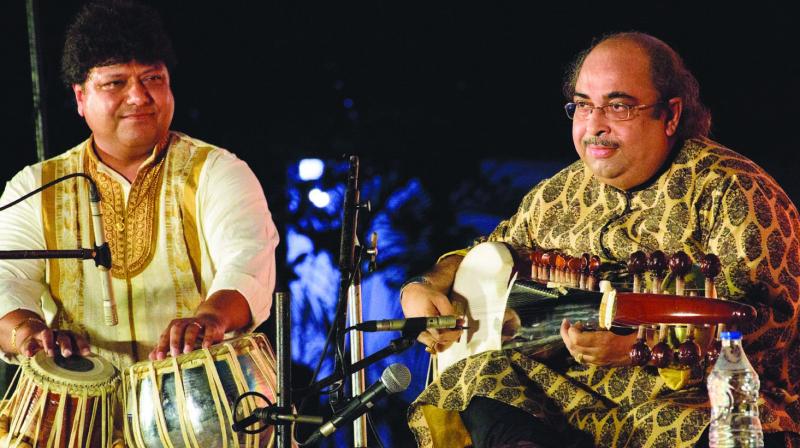The day Rajasthan was formed is celebrated on March 30th as Rajasthan Day. To kick off the celebrations, the state ministry of tourism collaborated with Spic Macay in their now regular monthly classical music concerts, Music in the Park, in Jaipur, with a concert by celebrated sarodiya Pandit Tejendra Narayan Mazumdar with the equally popular Pandit Subhankar Banerjee on tabla. Other events taking place, according to tourism ministry director Jyoti Khandelwal include a concert by Shankar Mahadevan and his band, an Army pageant, a “nagara”(percussion) show by awardee Nathu Lal Solanki, and a Police Tattoo.
The Music in the Park series, started originally in Delhi, is very prolific in Jaipur – there was a concert in early March by Gwalior gharana doyen Pandit Ulhas Kashalkar, and this season will end with a concert by Vidushi Shruti Sadolikar on April 14.
Pandit Tejendra Narayan Mazumdar, one of the senior players today of the Maihar Senia gharana (he learnt from Ustad Bahadur Khan, nephew of Maihar gharana founder Ustad Allaudin Khan, and after his Guru’s death, from Ustad Ali Akbar Khan) is no stranger to Jaipur – he remembered how he had first performed in the city in the early 1990s, touring with ITC SRA, Calcutta. Jaipur, of course had an old musical past with several renowned musicians settling in the city under the patronage of the Jaipur ruler. Ustad Alladiya Khan, the founder of one of the four main vocal gharanas of Hindustani music, the Jaipur Attrauli gharana, lived most of his life in Maharashtra which is the repository of his musical heritage even today, yet always retained the link with Jaipur, the home of his ancestors. When asked about the origins of his unusual path breaking singing style that he had himself developed, he had replied it was Jaipur gayaki, and thus was created the Jaipur Attrauli gharana.
The maestro started his recital appropriately with the Raga of the dusk, Shree, one of the 6 main Ragas in the Hindustani system. Shree is a very powerful Raga, and in one of the Ragamala paintings, is depicted as a woman holding her dead child in her lap. As such, the emotions of “vairaaga”(renunciation) that Shree Raga can churn up can be difficult to contain in a concert rendering; Pt Tejendra Narayan admitted he debated about whether he should play Raga Shree as it’s not something one can do light heartedly.
He started with an aalap, but did not continue the exploration in depth, and moved on quickly to the “jor” portion, as the sound system bothered him. The Raga was elaborated in a strictly dhrupad sombre style. Mastery of Ragas is knowing how to treat which Raga; the embellishments appropriate to Raga Shree are definately different to say, Raga Pilu, with which he ended the concert. Ending in traditional “larant”, (right hand stroke work) showing rabab craft and definitive stroke work, the gat that followed was in jhaptaal. The following drut bandish too was in jhaptaal, ending in a more prolonged than usual 5 bol jhala. It was indeed exhilarating to hear jhaptaal jhala at that speed; this is indeed rare. Both the gats were compositions of his own; the drut composition with an unusual off the beat coming to the sum.
With a maestro like Pandit Subhankar Banerjee on the tabla, laya work of an exalted caliber was expected; there were displays by both artists of one and a half times speed, double, two and a half, four! The chemistry between both players is visable; as is the mutual respect for one another’s music. Pt Subhankar Banerjee is a rare musician who one safely say has achieved the phenomenal success he has, entirely on his own merit, without the prop of a well known Guru or father — his Gurus, Farrukhabad’s Pandit Swapan Shiv, Pandit Manik Das of Banaras, and Lucknow gharana exponent Pandit Harisadhan Goswami were relatively less known. Subhankar in his extensive repertoire combines compositions from Punjab and Delhi also, along with Carnatic laya work seamlessly; he never sounds the same, even if one hears 3 or 4 concerts of his consecutively.
The concluding composition in Raga Pilu was in teen taal (16 beat cycle); a long old Senia gat composed by an unknown Senia Ustad in the 19th century.
Sadly, the audience was small; as one of the organizers said, that day in Jaipur there were two other cultural events, and the concert going audience of the city got divided.
A pity, as it was an excellent, thoroughly satisfying concert; the high level of music performed can only be achieved by totally confident musicians who have nothing left to prove to themselves or their audience.
Source : http://www.asianage.com/entertainment/music/020418/concerts-to-showcase-jaipurs-musical-past.html


